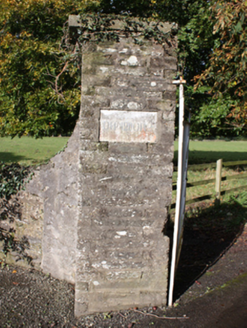Survey Data
Reg No
40828002
Rating
Regional
Categories of Special Interest
Architectural
Original Use
Gates/railings/walls
In Use As
Gates/railings/walls
Date
1800 - 1840
Coordinates
236990, 411703
Date Recorded
21/10/2008
Date Updated
--/--/--
Description
Gateway serving Dunmore House (see 40828003), erected c. 1820, comprising a pair of diagonally-set cement rendered ruled-and-lined rubble stone gate piers (on square-plan) having cut stone capstones over. Marble plaque to pier to the west with leaded engraved text reading ‘Dunmore’. Modern metal gates with ‘sunburst’ motifs. Gate piers flanked to either side (east and west) by quadrant sections of rubble stone walling having modern repairs in places, particularly to the west. Formerly with gate lodge to the west side of gateway, now demolished. Located adjacent to road to the east of Carrigans, and at start of tree-lined approach avenue to Dunmore House from the south. Sections of rubble stone boundary wall survive along roadscape to the south-west and west.
Appraisal
These simple but robust rubble stone gate piers serve one of the principal entrances to Dunmore House (40828003), with which they form part of a group of related sites. Despite some modern alterations, the quality of the stonework of the piers demonstrates fine traditional craftsmanship. The loss of the early gates is regrettable, and detracts somewhat from the integrity of this gateway. Their angled or diagonally-set position of the gate piers is a feature of a number of gateways in this part of Donegal, perhaps indicating a local tradition or fashion, and creates an engaging visual impact on the roadside. The marble name plaque to the west pier adds additional muted interest. The surviving flanking rubble stone quadrant walls add signi9ficantly to the setting and creates a sense of grandeur that is befitting a gateway serving a house of the quality of Dunmore. The surviving sections of boundary wall to the estate boundary add to the context and complete this composition. Their was formerly a gate lodge ( pre-1837) to the south-west side of the gateway, now demolished (post 1902).











